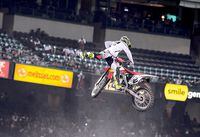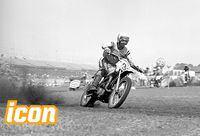When 16-year-old Marty Tripes won the inaugural Superbowl of Motocross at the Los Angeles Memorial Coliseum on July 8, 1972, it spawned a whole new sport. Bringing motorcycle racing to the fans and delivering a stick-and-ball-style viewing experience made the sport much more accessible to the everyman. Today, Monster Energy AMA Supercross plays to sold-out stadiums from New York to San Diego, with all 17 races broadcast live. The top riders are veritable rock stars, earning millions, and the lines for their autograph sessions often stretch the length of a football field.
This year the series celebrates its 40th anniversary—and, no, that math doesn’t add up. While the Superbowl of Motocross laid the groundwork, the first official AMA Supercross wasn’t held until March 10, 1974, at Daytona International Speedway. Dutchman Pierre Karsmakers topped the 250cc class that day and went on to win the championship.
To mark this momentous occasion, FELD Motor Sports made an even bigger deal out of its annual “Retro Night” held in conjunction with this year’s Anaheim II, honoring all 22 former Supercross champions during Saturday evening’s opening ceremonies. Before that was a “Throwback Thursday” press conference during which five past champs (six, including emcee Jeff Emig) joined current Red Bull KTM riders Ryan Dungey (the 2010 champ) and Ken Roczen, the German rookie who won his first 450cc race at the Anaheim I season opener.
The camaraderie among one-time rivals during the question-and-answer session was a breath of fresh air. Said two-time champ Jeff Ward, “At some point I probably hated Johnny [O’Mara, who was sitting beside him], but then mutual respect came in.”
The question everyone wanted to ask was, “How does Supercross today compare to back in the day?”
“It’s nothing like it,” Karsmakers said. “Back then it was all new, and we didn’t have any tracks like that to practice on. Today, everyone has a practice track.”
But even in the sport’s infancy, the Dutchman knew it held promise. “The Americans loved the spectacle. I always felt that it was going to be big.”
The other burning question: Which generation of riders was better? Karsmakers deflected that query: “When I was racing we gave our full 100 percent, and I can see now that the racers do the same.”
There was some talk of fitness, which accelerated in the 1980s. Dungey trained with 1984 champ O’Mara early in his career and said, “I thought I knew what a work ethic was before then, but he taught me a whole new ball game!”
Roczen joked that the older riders “may have enjoyed a beer now and then.” Nowadays diet is key: “I’ve always done the hard work, but before I might go for the hamburger. Not anymore.”
There was also talk of equipment. Today’s motorcycles are far superior, but production based. Before 1986, factory riders rode cost-no-object prototypes. Ward explained the downside to that: “We had a lot of bikes and triple clamps break in half—we were the test riders!”
In closing, the veterans were asked what advice they might give to the current riders. Jimmy Ellis, the 1975 champ, chimed in: “My one piece of advice for these guys is to know that it’s short-lived. It’s probably only a five-, six-, or seven-year career. I don’t know anybody who has gone 10 years and been a champion.”
Two days later, a current star made Ellis eat his words. A decade after claiming the first of his two titles, Chad Reed took a popular win. But while Reed won once more this season and fellow vet James Stewart won five races, in the end it was Ryan Villopoto who won seven races en route to his fourth consecutive championship.















/cloudfront-us-east-1.images.arcpublishing.com/octane/S35YGSEMEZB4BLTDJTSZPF4GLA.jpg)
/cloudfront-us-east-1.images.arcpublishing.com/octane/5UOT6HPX2JFMRJAX6EH45AR4MQ.jpg)
/cloudfront-us-east-1.images.arcpublishing.com/octane/OKWOJWAKP5EP3OACCRRWPCIX2Q.jpg)
/cloudfront-us-east-1.images.arcpublishing.com/octane/2WF3SCE3NFBQXLDNJM7KMXA45E.jpg)
/cloudfront-us-east-1.images.arcpublishing.com/octane/G4MG6OUCJNBSHIS2MVVOTPX65E.jpg)
/cloudfront-us-east-1.images.arcpublishing.com/octane/IIGGWFOTOJGB7DB6DGBXCCMTDY.jpg)
/cloudfront-us-east-1.images.arcpublishing.com/octane/QSTCM6AVEZA5JJBUXNIQ3DSOF4.jpg)
/cloudfront-us-east-1.images.arcpublishing.com/octane/U4I7G625B5DMLF2DVIJDFZVV6M.jpg)
/cloudfront-us-east-1.images.arcpublishing.com/octane/B6XD6LS6IVCQPIU6HXDJSM3FHY.jpg)
/cloudfront-us-east-1.images.arcpublishing.com/octane/ICL63FEDDRDTTMINYICCEYGMDA.jpg)
/cloudfront-us-east-1.images.arcpublishing.com/octane/FCGZHQXRBZFLBAPC5SDIQLVF4I.jpg)
/cloudfront-us-east-1.images.arcpublishing.com/octane/WNOB6LDOIFFHJKPSVIWDYUGOPM.jpg)

/cloudfront-us-east-1.images.arcpublishing.com/octane/X33NU3E525ECRHXLNUJN2FTRKI.jpg)
/cloudfront-us-east-1.images.arcpublishing.com/octane/6KKT5NNL2JAVBOXMZYS5ZO76YA.jpg)
/cloudfront-us-east-1.images.arcpublishing.com/octane/J5RKG5O455GMPGQRF2OG6LRT7A.jpg)
/cloudfront-us-east-1.images.arcpublishing.com/octane/GX2CIZKQVRH2TATDM26KFG2DAE.jpg)
/cloudfront-us-east-1.images.arcpublishing.com/octane/ZWIDYSAKQZHD5BHREMQILXJCGM.jpg)
/cloudfront-us-east-1.images.arcpublishing.com/octane/CYUHJZCTSJCH3MRAQEIKXK7SCQ.jpg)
/cloudfront-us-east-1.images.arcpublishing.com/octane/LKOFINY56FCXJCANJ5M7ZDQUBY.jpg)
/cloudfront-us-east-1.images.arcpublishing.com/octane/4NBPDACMWJH63JQYJVK3QRBDZI.jpg)
/cloudfront-us-east-1.images.arcpublishing.com/octane/KKHQHRR3FJGX7H2IPU6RALMWG4.jpg)

/cloudfront-us-east-1.images.arcpublishing.com/octane/5IOFS5JAE5FOXMNA23ZRAVVYUU.jpg)